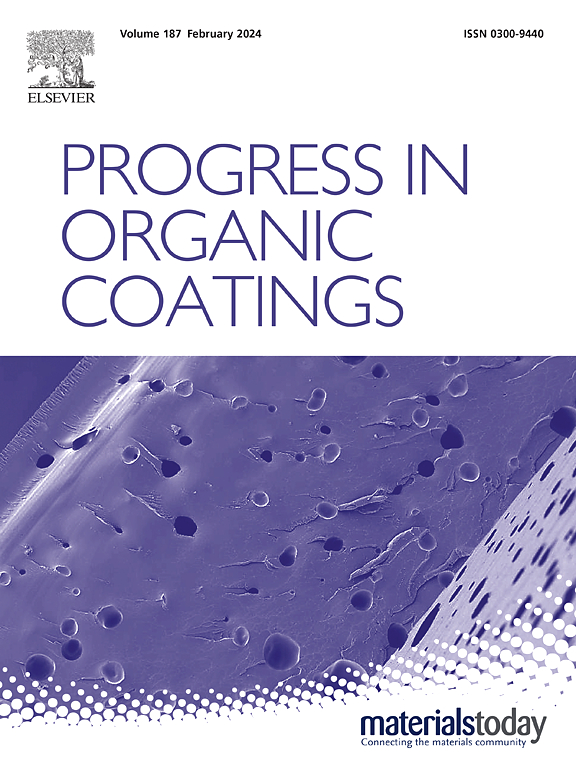A resilient superhydrophobic photothermal SiC/carbon coating for enhanced anti-icing and deicing performance under extreme environmental conditions
IF 7.3
2区 材料科学
Q1 CHEMISTRY, APPLIED
引用次数: 0
Abstract
Icing poses significant economic and safety challenges. While superhydrophobic surfaces offer excellent water repellency and reduced ice adhesion, their limited durability in cold conditions restricts practical use. To address this, photothermal superhydrophobic surfaces have been developed, but achieving high photothermal efficiency, exceptional anti-icing performance, and durability remains a challenge. In this study, a durable superhydrophobic photothermal anti-icing (SPAI) surface was fabricated on aluminum (Al) using SiC and carbon particles (CS) via a two-step spraying process. The SPAI surface was fabricated by applying an epoxy resin layer on aluminum surface, followed by spraying a mixture of modified SiC, and CS with polydimethylsiloxane (PDMS). The resulting surface demonstrated (i) excellent water repellency, with a water contact angle of 161° and a rolling angle of 5°, (ii) outstanding photothermal performance, achieving a 72.3 °C temperature increase under 1 sun illumination for 300 s, and (iii) superior mechanical stability and long-term durability. The SPAI coating demonstrated excellent anti-icing, deicing, and defrosting performance at −25 °C, with a freezing delay of 492 s and deicing/defrosting times of 130 and 141 s, respectively, under 1 sun exposure. It exhibited low ice adhesion strength (45 ± 10 kPa at −20 °C) and maintained durability, with ice adhesion remaining ~99 kPa after 13 icing/deicing cycles. Durability was validated through abrasion, cross-cut tape adhesion, and freeze-thaw tests. The surface also exhibited non-wetting properties when exposed to various food liquids and demonstrated excellent long-term stability in ambient conditions. The proposed surface offers a scalable, durable solution for anti-icing and deicing.

一种弹性超疏水光热SiC/碳涂层,可在极端环境条件下增强抗冰和除冰性能
结冰带来了重大的经济和安全挑战。虽然超疏水表面具有优异的拒水性和减少冰的粘附性,但其在寒冷条件下的有限耐久性限制了实际使用。为了解决这个问题,人们开发了光热超疏水表面,但要实现高光热效率、优异的防冰性能和耐用性仍然是一个挑战。本研究以碳化硅(SiC)和碳颗粒(CS)为材料,采用两步喷涂工艺在铝(Al)表面制备了一种耐用的超疏水光热防冰(SPAI)表面。通过在铝表面涂覆环氧树脂层,然后喷涂改性SiC和CS与聚二甲基硅氧烷(PDMS)的混合物来制备SPAI表面。所得到的表面表现出(i)优异的拒水性,水接触角为161°,滚动角为5°;(ii)出色的光热性能,在一个太阳照射300秒下实现72.3°C的温度升高;(iii)优异的机械稳定性和长期耐用性。SPAI涂层在- 25°C下表现出优异的防冰、除冰和除霜性能,在1次太阳照射下,冻结延迟为492 s,除冰/除霜时间分别为130 s和141 s。它具有较低的冰粘附强度(在- 20℃时为45±10 kPa),并保持了耐久性,在13次冰/除冰循环后,冰粘附强度仍为~99 kPa。耐久性通过磨损、横切胶带粘附和冻融试验验证。当暴露于各种食品液体时,表面也表现出不润湿特性,并在环境条件下表现出优异的长期稳定性。该表面为防冰和除冰提供了一种可扩展、耐用的解决方案。
本文章由计算机程序翻译,如有差异,请以英文原文为准。
求助全文
约1分钟内获得全文
求助全文
来源期刊

Progress in Organic Coatings
工程技术-材料科学:膜
CiteScore
11.40
自引率
15.20%
发文量
577
审稿时长
48 days
期刊介绍:
The aim of this international journal is to analyse and publicise the progress and current state of knowledge in the field of organic coatings and related materials. The Editors and the Editorial Board members will solicit both review and research papers from academic and industrial scientists who are actively engaged in research and development or, in the case of review papers, have extensive experience in the subject to be reviewed. Unsolicited manuscripts will be accepted if they meet the journal''s requirements. The journal publishes papers dealing with such subjects as:
• Chemical, physical and technological properties of organic coatings and related materials
• Problems and methods of preparation, manufacture and application of these materials
• Performance, testing and analysis.
 求助内容:
求助内容: 应助结果提醒方式:
应助结果提醒方式:


